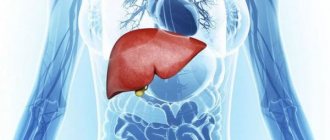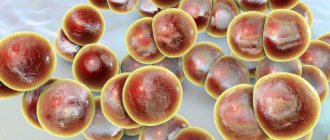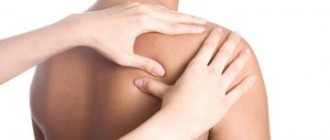The cause of discomfort in the right hypochondrium is most often gastroenterological pathologies. They require urgent medical intervention. In this article we will look at the main factors that cause heaviness in the right side under the ribs in the front, middle and back.
Almost always, a feeling of fullness in the right hypochondrium signals the development of a dangerous disease.
Types of discomfort in the right side
Based on the characteristics of the symptoms that arise in the hypochondrium, one can determine the possible cause of their occurrence. To do this, it is necessary to understand the differences between sensations in their nature and intensity.
Heaviness
This type of discomfort can also be felt by healthy people, since it is not always a harbinger of disease. For example, people who constantly experience anxiety quite often feel a heaviness in their chest, describing this condition as “the inability to breathe deeply.”
Pain
The pain is felt much more acutely than simple heaviness, and is also a sign of more serious abnormalities. People who run are familiar with the attack of acute colic that overtakes them if they do not warm up before running. In all other cases, you need to pay attention to this symptom and consult a doctor.
Feeling of fullness
With this type of discomfort, there is a feeling as if something is pressing from within. When bursting pain occurs, it may seem to a person that there is some kind of foreign object in the area where it is localized, something extra that shouldn’t be there.
Bloating
A well-known phenomenon that occurs due to the accumulation of gases is flatulence. It is accompanied by rumbling, an increase in the size of the abdomen, as well as flatulence (in simple terms, a person farts a lot).
Folk remedies
Herbs that can relieve heaviness in the liver area are presented in the table.
Table 7. The most effective herbs.
| Means | What does it help with? | What is better to combine with? | What to cook? |
Walnut leaves. | Intoxication, serious liver dysfunction. | With Sarepta mustard seeds, medicinal dandelion flowers, white willow bark. | Decoction. |
Small periwinkle. | Elimination of heaviness on the right side of the abdomen, relief of spasms. | With golden sarothamnus herb, calendula flowers, coriander fruits, caraway seeds. | Infusion. |
Immortelle. | Diseases of the liver and gall bladder. | — | Tea. |
Corn silk. | Liver diseases. | With plantain, rose hips. | Decoction. |
Spotted milk thistle. | Liver diseases. The herb promotes tissue repair. | Hop cones. | Decoction. |
Note! After treatment of the liver and gallbladder, it is recommended to drink oatmeal jelly.
The duration of herbal medicine is 90 days.
Causes
Discomfort can occur for various reasons and, as a rule, pain in the right side is associated with the digestive organs. However, this is not always the case, therefore, under no circumstances should you engage in self-diagnosis, so as not to harm yourself even more.
Causes of acute pain in the side:
- Hepatitis is a disease transmitted in different ways (sexual, airborne, long-term use of medications, etc.) and affects the liver. Due to the resulting pathology, it increases in size, stretching its own membrane. Because of this, pressing pain occurs in the hypochondrium with irradiation to the scapula and shoulder.
- Heaviness in the right side under the ribs in front may be a sign of cirrhosis. This is another liver disease that can be caused by the abuse of junk food, alcohol, as well as advanced diseases. The pain is localized in the right side and, depending on the severity of the pathology, can be either dull or acute.
- Echinococcus. Parasites that provoke the formation of cysts in the liver. As their size and number increase, the affected portion of the organ grows, causing a feeling of heaviness and fullness.
- Cholecystitis. Stagnation in the gallbladder, which can be caused by disturbances in the functioning of the body, as well as frequent consumption of harmful foods. The pain is acute, up to painful shock. In the chronic form of the pathology, it is dull, lethargic, worsening when deviating from the diet or due to stress.
- Appendicitis. Inflammation of the appendix causes acute pain in the navel area, which then gradually moves to the right side. Requires immediate medical attention, as delay threatens organ rupture and subsequent development of peritonitis.
- Cancer. Pain in the side that practically does not go away can signal oncology of the internal organs. The right hypochondrium can be affected by pathologies of the stomach, intestines, pancreas, and so on.
- Pancreatitis. With this inflammation of the pancreas, pain is usually localized on the left, but it is important to know that it can also move to the right side. This can make it difficult to make a correct diagnosis, which means it is necessary to focus on additional signs of the disease.
- Heart. With heart attacks, severe pain occurs on the right side, and if it radiates to the right arm, most likely we are talking about this particular condition.
- Thrombosis of the vena cava causes quite severe pain in the lower back and in the right hypochondrium from behind.
- Problems with the genitourinary system. Cystitis, pyelonephritis and other diseases of the kidneys, bladder and other adjacent organs can cause discomfort in the side. The pain in this case is constant and quite tolerable.
- Inflammation of the colon - ulcerative colitis. This pathology is indicated by bloating of the abdomen, accompanied by gurgling and severe colic.
- Pneumonia causes a feeling of fullness in the right hypochondrium if the right lung is affected.
- Intercostal neuralgia is characterized by acute pain that intensifies with movement (turning, bending).
- Osteochondrosis. The pain radiates from the affected lower back and can vary in intensity depending on the severity.
- Rib injuries, damage to internal organs.
In addition to the general reasons described, there are also gender reasons - different for men and women. For example, pain in the right side of the stronger sex can be caused by pathologies of the prostate gland.
Causes of pain in women:
- pregnancy (both ectopic and normal);
- consequences of abortion;
- pathological menstruation;
- ovarian diseases;
- oncology of the reproductive system;
- proliferation of the inner layer of the uterus - the endometrium.
The cause of pain may not necessarily be some pathology. Often discomfort is a consequence of certain actions or very ordinary physiological conditions.
Other causes of heaviness in the side:
- critical days;
- pregnancy;
- poor nutrition;
- excessive physical activity;
- stress.
General information
The right hypochondrium refers to the area of the anterior abdominal wall.
Table 1. What is the right hypochondrium limited by?
| Above | Diaphragmatic projection (5th rib). |
| From below | The lower border of the ribs and arches. |
| Interior | A line passing vertically through the point of the ribs, which is located at the very bottom. |
| External part | A line extending vertically from the iliac crest. |
What organs are there?
Pain may come from nearby organs
The following organs are located in the right hypochondrium:
- adrenal;
- liver;
- peritoneal portion of the right half of the diaphragm;
- gallbladder;
- flexure of the colon;
- the upper part of the right kidney.
Note! Discomfort that occurs in the right hypochondrium can radiate from the bile ducts, duodenum, inferior vena cava and pancreas.
Additional symptoms
In order to diagnose a particular disease, the mere presence of pain is not enough, since it can be a sign of several pathologies at once. There must also be additional signs accompanying the unpleasant sensations.
What symptoms can be used to identify a disease accompanied by pain in the right side:
- Liver lesions. Increased temperature, loss of appetite, nausea, vomiting, yellowing of the eye sclera and skin.
- Echinococci show virtually no symptoms in the early stages. A person's stamina decreases and he gets tired quickly. A small rash and a slight increase in temperature appear. Appetite gradually decreases and weight loss occurs. When eating heavy food, digestion may be upset - nausea, vomiting, diarrhea. In the worst case, the cyst suppurates and subsequently ruptures, which can lead to blood poisoning with all the ensuing consequences.
- Cholecystitis. It is important to know that in some cases it can be asymptomatic, appearing quite unexpectedly in the examination results. In other cases, depending on the severity of the lesion, the symptoms can be either severe or quite tolerable. Weakness, fever, muscle aches, indigestion, bitter taste in the mouth, intolerance to fatty foods, and so on.
- Appendicitis is characterized by the fact that when walking and taking an upright position, the pain becomes more intense. That is why a person experiencing an attack tends to take the fetal position and bend over.
- Pancreatitis manifests itself as nausea, vomiting, pallor, and cold, sticky sweat.
- In addition to pain, a heart attack will cause confusion, trembling hands, bluish lips and pale skin.
- Ulcerative colitis is accompanied by fever, weight loss, temperature, and impurities in the stool (blood, pus, mucus).
- With pneumonia, the pain intensifies during coughing.
When urgent help is needed for pain under the ribs
In the following situations, urgent help is needed if you feel sharp pain under your right rib.
Serious injury
A fall or a strong blow can cause damage or even rupture of abdominal organs and pain in the right side. The most dangerous are rupture of the liver and kidney, which can provoke severe bleeding, which can lead not only to pain but also to death. Symptoms of bleeding are:
- strong heartbeat;
- “cold” sweat, chills;
- pale skin;
- dizziness, fainting.
Acute appendicitis
This is an acute inflammation of the appendix, an extension of the intestine, which is felt as pain in the right side under the ribs. If it occurs, you cannot do without surgical intervention, otherwise peritonitis may develop - when all the organs of the abdominal cavity are involved in the inflammatory process. Therefore, it is extremely important to consult a doctor immediately if you have the following symptoms:
- severe aching or stabbing pain on the right side of the abdomen, especially typical when it starts in the center under the sternum and is practically not relieved by painkillers;
- symptoms of intoxication: fever, chills, nausea, vomiting;
- muscle tension, pain in the peritoneum in the right side, which indicates that the process is beginning to spread.
A consultation with a surgeon will help determine the symptoms of appendicitis.
Acute cholecystitis
The second most common disease that causes inflammation of the gallbladder, leading to pain. This happens, for example, if there are stones in it, which will cause acute pain in the right side under the ribs. In the case of acute cholecystitis (diagnosed by a surgeon or therapist), urgent surgical intervention is necessary in order to have time to remove the bubble before other organs are involved in the process. Symptoms of the disease are similar to appendicitis:
- pain in the right side of the abdomen: constant, often severe, slightly relieved by antispasmodics;
- yellowing of the skin;
- nausea and vomiting that does not bring relief;
- an increase in temperature is not always possible;
- chills, weakness.
Acute intestinal obstruction
This is a dangerous condition that, without proper help, can lead not only to pain, but also to death. It is dangerous because when the contents of the intestine linger in it for a long time, it begins to be absorbed into the blood and poison the entire body. In some cases, a rupture of the wall and intestine occurs, and the contents leak into the abdominal cavity - this is called “fecal peritonitis.” This condition often ends in death. Find out about the causes and quick methods to eliminate constipation here. Intestinal obstruction occurs for the following reasons:
- disruption of normal intestinal function: normally, the intestinal walls “push” the contents through the intestines, but with poor nutrition and various diseases, the process is disrupted;
- “overlapping” of the intestinal lumen with a tumor or foreign object;
- torsion, compression of the intestine;
- a section of the intestine gets into the hernia and becomes pinched in it.
Symptoms of intestinal obstruction:
- sharp, spastic attacks;
- nausea, vomiting without relief;
- lack of stool;
- pallor, poor health.
Acute myocardial infarction
The cause of acute myocardial infarction is a thrombus in a vessel
Consequences
Any disorder, be it illness or injury, can lead to complications in the absence of medical intervention.
Depending on the disease:
- Hepatitis can lead to various consequences, which depend on the type of virus. The simplest (A) threatens liver failure. Virus B threatens with intoxication of the body and hepatic encephalopathy. Hepatitis C causes bone problems, and Hepatitis D leads to kidney problems. The most severe type of the disease (E) leads to hepatic coma - the person falls into an unconscious state and has no reflexes.
- Cholecystitis leads to various types of damage to the gallbladder, up to the complete loss of its ability to work.
- Untimely treatment for appendicitis can lead to rupture of the appendix and the development of peritonitis. It can cause intoxication of the body, dehydration, and acute renal failure. In the worst case scenario, death is possible.
- In the absence of proper treatment, pancreatitis progresses to a severe phase. The process of intoxication begins, kidney damage, brain swelling. The chance of death can reach 70%.
- Untreated pneumonia leads to the development of bronchial asthma, chronic bronchitis, fibrosis of the lung tissue, damage to the liver and pancreas, as well as a general decrease in immunity.
Why does the feeling of heaviness occur?
The liver is a vital gland located in the right hypochondrium. Its importance is due to its wide range of functions.
The gland is a kind of “filter”: blood with toxins, allergens and harmful substances flows through the veins, where they are neutralized and removed from the body.
In addition, the liver produces bile components and is involved in the process of digesting food.
The gland synthesizes many vitamins and microelements, which are stored in a special depot and allow the body to function normally.
High load on the liver often leads to malfunctions in its functioning. Since liver cells do not have nerve endings, a person may not feel severe pain for a long time (the nerve endings of the liver capsule can signal pain).
One of the early symptoms of problems with the gland is a feeling of heaviness in the liver area.
There are several reasons for the appearance of unpleasant sensations:
- poor nutrition;
- drinking alcohol;
- hepatitis;
Eating fatty and fried foods increases the load on the entire gastrointestinal tract.
Especially with poor nutrition, the liver and pancreas suffer. The organs do not have time to remove toxins and excess cholesterol, as a result, intestinal motility slows down and the outflow of bile is disrupted.
Often, a passion for junk food leads to the development of inflammatory diseases of the abdominal organs: gastritis, cholecystitis, etc.
In the absence of timely treatment, the severity can turn into aching or acute pain, accompanied by nausea and vomiting.
Excessive alcohol consumption leads to an increase in toxins in the blood. The liver is not able to cope with such a volume of harmful substances, and gradually toxins accumulate, leading to inflammation and discomfort in the abdominal area. A malfunction of the liver after alcohol can feel heaviness and nausea.
Sometimes when running, unprepared people experience a feeling of heaviness or pain in the liver area. This sensation is associated with improper breathing technique or activity immediately after eating.
Movement accelerates blood circulation, the liver quickly fills with blood without having time to filter it. The liver capsule stretches, and unpleasant sensations of heaviness and pain appear.
One of the symptoms of hepatitis at an early stage of development of the disease is a feeling of heaviness in the liver area.
Heaviness and pain in the liver area are often associated with problems in the functioning of the nearby gallbladder and pancreas.
These organs are involved in the process of removing bile and can cause pain and heaviness on the right side.
Therapeutic diet
Doctors for acute and chronic liver diseases prescribe dietary table No. 5. The menu is based on light dishes that do not put a serious burden on the gastrointestinal tract and do not contain a large number of toxins and allergens.
Fried, fatty, spicy and fast food should be excluded from the diet. Food with heaviness in the liver area should be steamed or oven-baked. It is recommended to adhere to fractional meals (5-6 times a day, in small portions).
The menu for liver diseases is dominated by pureed soups in vegetable broth, chicken and fish cutlets, fermented milk products, and jelly.
Foods high in fat should be limited as much as possible, giving preference to foods rich in proteins.
In addition to diet, you should definitely visit a gastroenterologist, who can determine the cause of the feeling of heaviness in the liver area and select an individual treatment regimen.
To relieve stagnation of bile, choleretic agents are prescribed. These medications help unblock the flow of bile and release it into the duodenum. Allochol is considered a proven and fairly safe choleretic drug.
Allochol is developed based on natural ingredients, so it does not increase the amount of toxins in the blood and does not increase the load on the liver.
The drug improves the secretory function of liver cells - hepatocytes, stimulating the synthesis of a sufficient amount of secretion.
Allochol accelerates the outflow of bile through the ducts and its removal. As a result of intake, inflammation is reduced, the risk of gallstone formation is reduced, and the process of food digestion is normalized.
Allochol is available in tablets and is taken 1-2 tablets three times a day. The drug must be taken after meals.
The duration of treatment is 3-4 weeks. To consolidate the effect at the end of the dose, a preventive course is recommended: 1 tablet twice a day.
Preventive therapy lasts up to 2 months. A repeated course of treatment can be carried out only after a break of 3 months.
Contraindications for the drug include acute hepatitis, liver dystrophy, jaundice, and stomach ulcers. Medicines for gallstone disease are used with caution and only under the supervision of a physician.
Diagnostics
If you experience pain in the right side, you should contact an appropriate specialist as soon as possible. It is recommended to first visit a therapist, who, after a survey and initial examination, will refer you to a doctor with a more specialized profile. This is necessary because the cause of discomfort can be the digestive, respiratory, cardiovascular system and much more.
At the first visit, the attending physician interviews the patient, conducts an external examination and carefully palpates the abdominal area.
Studies that may be ordered in the future:
- general and biochemical blood test;
- Analysis of urine;
- stool analysis for the presence of parasites;
- Ultrasound (ultrasound examination) of the abdominal cavity;
- gastroscopy;
- MRI (magnetic resonance imaging);
- CT (computed tomography);
- X-ray.
What should I do?
When the first alarming symptoms appear, you should seek help from a doctor as soon as possible.
After the initial examination, the therapist may refer the patient to:
- gastroenterologist;
- nephrologist;
- surgeon;
- cardiologist;
- vertebrologist;
- traumatologist
The table presents methods of primary diagnosis.
Table 4. What does the doctor do first?
| Doctor's action | Description |
Getting to know your medical history. | This helps to identify the root cause. |
Anamnesis collection. | The method is necessary to confirm or refute exposure to non-hazardous sources. |
Detailed inspection. | The specialist assesses the condition of the skin, sclera, and mucous membranes. Then the doctor carefully palpates the anterior wall of the peritoneum. |
Blood pressure measurement. | Temperature and heart rate indicators are also measured. |
Auxiliary diagnostic methods are presented in the table.
Table 5. Features of secondary diagnostics.
| Laboratory research | Instrumental diagnostics |
| PCR and hormonal testing, liver tests, stool examination under a microscope, biochemical blood test, general clinical blood and urine tests. | Ultrasound examination of the abdominal organs, MRI, CT, ECG, endoscopy. Gastroscopy is also performed. If necessary, the patient undergoes a biopsy. |
You can relieve discomfort without medications using a compress
The instructions look like this:
- Take a horizontal position and try to calm down.
- If a feeling of fullness in the right hypochondrium is accompanied by swelling in this area, vomiting and severe pain, you should call an ambulance as soon as possible. This symptom may indicate inflammation of the appendix.
- If a feeling of heaviness in the right hypochondrium is accompanied by aching pain, you can place a compress on the sore area. It is recommended to apply a cold towel or ice pack.
- If the pain does not disappear, you can take 1 tablet of No-shpa. This drug is not recommended for those with hypersensitivity to sodium metabisulfite.
- You can relieve severe pain with a glass of heavy cream. The liquid flows around the gastric walls, preventing the acidic secretion from irritating its surface.
The tablet describes the features of drug therapy.
Table 6. Drug treatment.
| Pathology | What medications are prescribed? |
Liver diseases | Antiviral drugs, detoxifying drugs, anticholestatics, glucocorticosteroids, hepatoprotectors. |
Osteochondrosis | Analgesics, anti-inflammatory drugs, chondroprotectors. |
IHD | Beta-blockers, antiplatelet agents, vasodilators. |
In case of acute pancreatitis, urgent surgery is prescribed. The cost of delay can be very high.
Treatment
Since the causes of discomfort in the right side can be pathologies of various organs, treatment, accordingly, is prescribed depending on the results of the study.
Causes and treatment of heaviness in the right hypochondrium:
- In case of liver diseases, first of all, it is necessary to follow a strict diet, since junk food increases the load on the organ. To strengthen it, you need to take vitamins and hepatoprotectors. It is necessary to reduce physical activity (up to bed rest, depending on the severity of the lesion). For viral hepatitis, antiviral drugs are taken, for autoimmune hepatitis, immune suppressants are taken.
- Cholecystitis is treated conservatively or surgically. In the first case, diet, medications (antibiotics, antispasmodics, immunomodulators, etc.), as well as extracorporeal lithotripsy are recommended - crushing stones without breaking the integument, using shock waves. If conservative methods do not bring a positive result, surgery is prescribed.
- Appendicitis is usually removed surgically, but it happens that inflammation of the appendix can be relieved with medications. More often, doctors simply remove the appendage, but if the disease is detected early, it is possible to save it. Treatment is carried out with antibiotics, pain is relieved with antispasmodic drugs. But in no case should you decide on such therapy on your own, since a ruptured appendix can lead to disastrous consequences.
- Treatment of pancreatitis includes reducing physical activity, following a diet, taking vitamins, normalizing the acid-base balance, and taking enzymes to normalize the digestive system. In emergency cases, surgical intervention may be prescribed.
- In case of pneumonia, it is necessary to adhere to bed rest and a certain diet plan. The room in which the patient is located must be regularly ventilated. It is necessary to take antibiotics and antibacterial drugs, antiviral and antipyretic drugs (as an adjuvant to eliminate symptoms). Physiotherapy and therapeutic exercises are possible as additional measures.
Traditional methods can be used to support the main treatment. In no case should you use home remedies instead of medical ones, but as additional therapy, these methods can be of great help.
When choosing traditional medicine recipes, you should consult your doctor.
Pain after eating
Eating accelerates the secretion and movement of bile, increases blood flow to the liver and stimulates intestinal peristalsis. Therefore, food provokes pain in pathologies of the liver, gall bladder, and intestines.
In this case, the nature of the pain can be different: nausea and dull pain are characteristic of cholecystitis, sharp pain of a spastic nature accompanies colitis and intestinal dysbiosis, stabbing pain accompanies biliary dyskinesia or cholelithiasis.
Prevention
To prevent and timely detect diseases, it is necessary to regularly visit a doctor. Completing medical examinations and routine examinations will help to identify the disease at an early stage and eliminate it at the initial stage.
Besides:
- Follow a daily routine.
- Eat right.
- Give up bad habits.
- Move more and strengthen your body.
- Do not ignore even the most minor sores, as they can cause complications.
- Learn to cope with stressful situations.
After load
Unpleasant sensations in the form of nagging or stabbing pain occur after physical exertion in people with hepatitis, cirrhosis, or congestive liver. After shaking or physical exertion, an attack of calculous cholecystitis may occur. Also, periodic pain during exercise appears in patients with myositis, intercostal neuralgia, osteochondrosis, rib fractures, and vena cava thrombosis.
Symptoms
If heaviness and pain in the right hypochondrium are not justified by a pathological process, then additional symptoms, as a rule, are absent.
In gastroenterological diseases, heaviness in the area of the right hypochondrium may be accompanied by the following symptoms:
- bloating;
- changes in the frequency and consistency of stool; stool may be watery and contain particles of undigested food. Attacks of diarrhea can occur up to 10 times a day;
- loss of appetite;
- rumbling in the stomach, flatulence;
- heartburn, belching with an unpleasant odor.
In liver diseases, heaviness and pain in the right hypochondrium in front are accompanied by the following symptoms:
- nausea, vomiting often mixed with bile;
- feeling of fullness in the right hypochondrium;
- yellowness of the skin, which is a specific sign of hepatitis;
- weight loss due to loss of appetite and frequent bouts of diarrhea;
- weakness, increased fatigue;
- irritability, sudden mood swings;
- low-grade body temperature;
- liver enlargement.
Often, heaviness in the area of the right hypochondrium can be a sign of the onset of the inflammatory process of the appendix, which manifests itself in the following clinical picture:
- nausea with vomiting;
- increased, as the pathological process worsens, high body temperature;
- sharp, cramping pain in the abdomen;
- profuse sweating;
- high blood pressure.
This human condition is characterized by a high risk of death.
If the cause of the development of this symptom is osteochondrosis of the lumbar region, then heaviness in the area of the right hypochondrium is almost always accompanied by pain and the following symptoms:
As the pathological process worsens, the clinical picture may be accompanied by symptoms of hepatic colic. The heaviness in the right hypochondrium is constant, which intensifies with minimal physical exertion.
If this symptom is a manifestation of cardiovascular pathologies, then the following specific signs are likely to occur:
- dyspnea;
- heaviness in the hypochondrium, which is accompanied by pain;
- unstable blood pressure;
- feeling of tightness in the chest area;
- nausea, rarely with bouts of vomiting;
- increased sweating.
The presence of any of the above-described clinical pictures requires immediate medical attention, since timely diagnosis significantly increases the effectiveness of treatment and the chances of a full recovery. Self-medication is unacceptable.
When should you see a doctor immediately? ↑
A patient suffering from numerous vomiting, diarrhea or constipation that does not stop during the day needs immediate examination.
It is worth remembering that the appearance of pain may indicate a danger to the patient’s life and health (appendicitis, ectopic pregnancy, organ ruptures, etc.).
An increase in temperature to high degrees is also a reason to immediately consult a doctor.
Almost every person over 40 years old suffers from such a disease as spinal osteochondrosis. Read about the reasons for the development of osteochondrosis in the lumbosacral region in our article - osteochondrosis of the lumbosacral spine.
Osteochondrosis of the cervical spine is considered the second most common. You can find out about it here.
Osteochondrosis most rarely affects the thoracic spine. You can read about it here.
What should you do if heaviness appears on the right side in the projection of the liver?
One of the important conditions for quickly improving the condition of a person who has suddenly developed heaviness behind the lower right rib - near the liver, medical workers indicate immediate consultation with a doctor. Attempts to cope with unpleasant sensations on your own can lead to serious complications - for example, in the case of acute surgical pathology.
Only if a person is firmly convinced that the severity was caused by overeating or physical activity, is it permissible to first take an antispasmodic tablet - Drotaverine or No-shpa. However, if there is no positive result, it is better to go to the clinic or call an ambulance.
It is absolutely unacceptable to carry out other auxiliary procedures - applying a hot heating pad to the liver area or taking anti-inflammatory or antibacterial drugs. They subsequently distort the clinical picture of the disease and complicate differential diagnosis.
It is also inadvisable to endure heaviness and aching pain in the internal organs, hoping that they will go away on their own. Delaying contact with a doctor only worsens the prognosis - only rapid identification of the cause of the disorder and its elimination leads to success in the form of recovery.
Nature of the pain syndrome
The pain radiates under the shoulder blade
A considerable number of nerve endings under the shoulder blades leads to the fact that pain from other organs can be transmitted here.
This is typical for pyelonephritis, pancreatitis, and angina. The affected organ itself is located distant from the area of the shoulder blades, but nerve fibers transmit pain sensations here. Acute pain under the shoulder blade
Sudden acute pain is a sign of osteochondrosis or disc herniation. Chondrosis rarely affects only the thoracic spine, but with such a lesion, the back hurts specifically in the area of the shoulder blades.
Increased pain during movements and lifting weights is a direct symptom indicating back problems.
Aching pain Stitching pain
By morning, such unpleasant sensations disappear.
Paroxysmal pain under the shoulder blade
cholelithiasis
Sharp pain may occur sudden sharp pain
- lungs (pneumothorax) – shortness of breath, inability to breathe;
- liver or large vessels (internal bleeding) - weakness, pallor, rapid heartbeat;
How can the feeling of pain manifest itself?
The nature of the sensation is of considerable importance in determining the cause of heaviness under the right hypochondrium. Based on this feature, specialists are able to distinguish a sluggish pathological process from an acute condition and take measures accordingly.
Discomfort
The feeling of discomfort is usually caused by a dull, barely noticeable pain, which indicates a hidden chronic pathology - from chronic cholecystitis to a tumor formation in the abdominal cavity.
Burning
Impaired outflow of bile (dyskinesia), cholelithiasis, cholecystitis, hepatitis and cirrhosis of the liver often cause a burning sensation in the hypochondrium, accompanied by heaviness in the right side. The same sensations are observed with pancreatitis and duodenal ulcer. Acute appendicitis can also begin with a burning sensation in the right hypochondrium, spreading to the lower abdomen. If this is accompanied by periodic acute pain in the same area, it is advisable not to hesitate to call a doctor.
Distension
A feeling of heaviness and fullness is usually associated with pathological growth of the liver or spleen, or, more often, both organs at the same time (hepatosplenomegaly). An increase in organ size is a pathological process in which healthy parenchyma cells are replaced by fatty or fibrous tissue that is not capable of performing the functions of the replaced cells.
Distension can also occur as a result of increased gas formation, then it is localized not only in the right hypochondrium, but throughout the entire epigastric region and the lower part of the abdominal cavity.
If it occurs after eating
If a person does not overeat, but heaviness under the rib still appears after eating, this indicates obvious disturbances in the functioning of the digestive system, from ulcerative colitis and duodenitis to tumor diseases of the intestine. The causes of heaviness in the hypochondrium after eating can be determined by undergoing an ultrasound of the abdominal cavity, endoscopy or other studies.
If accompanied by bloating
Flatulence (increased gas production in the intestines) is manifested by bloating and heaviness in the right hypochondrium and throughout the abdominal cavity. In the gastrointestinal tract of a healthy adult there is approximately 1 liter of gases, up to half of which should normally be eliminated per day through the processes of defecation and flatus (emission of gases through the rectum).
Bloating indicates flatulence and dysfunction of the digestive system. Many products provoke increased flatulence (gas formation):
- highly carbonated drinks, apples, cabbage, legumes, some nuts;
- products that cause fermentation - yeast black bread, kombucha, beer, bread kvass;
- dairy products - especially in people who are lactose intolerant.
But there is also a pathological nature of bloating:
- inflammatory processes or imbalance of microflora in the intestines;
- intestinal obstruction;
- intestinal helminthiases;
- acute intestinal infections;
- liver cirrhosis, colitis, enteritis, pancreatitis and other gastrointestinal diseases.
Suspicion of any of the listed pathological conditions should serve as a reason for in-depth research.
Diseases of the urinary system
A person’s right kidney is also located behind and to the right. A dull pain in the right side of the back may indicate its inflammation (pyelonephritis). It intensifies when moving, shaking in transport. Associated symptoms may include pain when urinating and swelling of the limbs and face. The disease can be diagnosed and differentiated from others only in a clinical setting, based on urine and blood tests and ultrasound results.
Back pain under the ribs is often caused by movement of a kidney stone. In the chronic stage of the disease, the nature of the discomfort is aching; it often appears after intense exercise. But when the ureter is blocked, the pain syndrome is expressed by unbearable pain, which can only be eliminated with the help of medications. If severe, growing pain appears, you should immediately call an ambulance.
Diseases of the urinary system
Video
This video describes three causes of discomfort in the right hypochondrium.
Heaviness in the right hypochondrium is a symptom of a certain pathological process, most often of a gastroenterological nature. However, diseases of other organs and systems of the body are no exception.
Sometimes this symptom is not a sign of a pathological process, for example, with excessive physical exertion. If a feeling of heaviness in the right hypochondrium is constantly observed and additional symptoms are present, you should consult a doctor for qualified medical help. Self-medication or ignoring symptoms is unacceptable.
Pain in acute appendicitis
The appendix is a lymphoid organ that takes part in the immune defense of the digestive system. It is located in the area of the right ilium, but its position is quite variable. This causes difficulties in diagnosing inflammation of the appendix. Appendicitis has its own distinct stages of development, which only a surgeon can diagnose.
Signs of appendicitis are:
- Diffuse pain in the navel and stomach;
- The pain is localized in the right half of the abdomen for three hours;
- Reducing pain when lying on the right side;
- Increased pain when walking and lying on the left side;
- Against the background of pain, general health worsens, body temperature rises, vomiting and diarrhea occur.
In such cases, emergency surgical treatment is performed in a surgical hospital.











